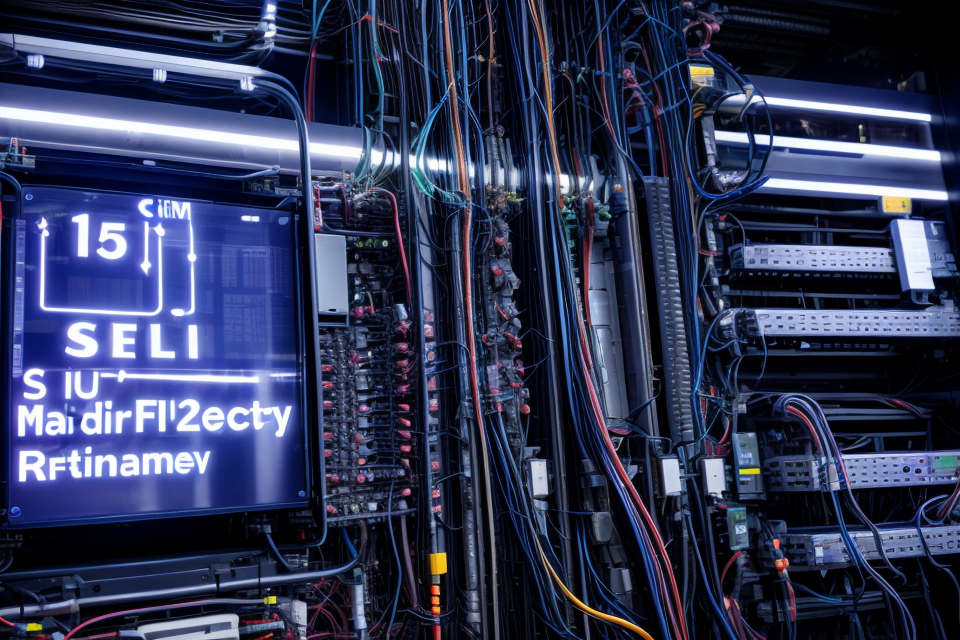The question of how often network maintenance should be done is one that many businesses and organizations grapple with. The truth is, the answer depends on a variety of factors, including the size and complexity of your network, the amount of traffic it handles, and the type of equipment you’re using. However, there’s one thing that’s clear: regular network maintenance is essential for optimal server performance.
In this article, we’ll explore the key elements of network maintenance and why they’re important. We’ll also look at some best practices for maintaining your network, so you can ensure that it’s running at peak performance at all times. Whether you’re responsible for a small business network or a large enterprise network, the information in this article will help you keep your network running smoothly and efficiently.
Network maintenance should be performed regularly for optimal server performance. This includes tasks such as updating software, checking for and addressing security vulnerabilities, and monitoring system performance. The frequency of network maintenance will depend on the specific needs of the server and the environment it is running in. It is recommended to have a maintenance schedule in place and to follow it consistently. Regular maintenance will help ensure that the server is running efficiently and effectively, which can help prevent downtime and improve overall performance.
Understanding Network Maintenance
Importance of Network Maintenance
- Ensuring smooth server operation: Regular network maintenance is crucial for the seamless functioning of servers. It involves monitoring and managing network devices, configurations, and traffic to ensure optimal performance.
- Preventing downtime and data loss: Network maintenance helps in identifying and resolving potential issues before they cause significant problems. This prevents downtime and data loss, which can be detrimental to businesses.
- Identifying and resolving potential issues: Network maintenance involves identifying and resolving potential issues before they cause significant problems. This includes monitoring network performance, identifying bottlenecks, and optimizing network configurations.
In summary, network maintenance is crucial for the optimal performance of servers. It helps in ensuring smooth server operation, preventing downtime and data loss, and identifying and resolving potential issues.
Types of Network Maintenance
Preventive Maintenance
Preventive maintenance is a proactive approach to network maintenance that involves regularly scheduled tasks designed to prevent network issues before they occur. This type of maintenance typically includes tasks such as system backups, firmware updates, and hardware checks. By performing these tasks on a regular basis, network administrators can identify and address potential issues before they become serious problems.
Corrective Maintenance
Corrective maintenance is a reactive approach to network maintenance that involves addressing network issues as they arise. This type of maintenance is typically required when a network issue has already occurred, such as a hardware failure or a software bug. The goal of corrective maintenance is to quickly resolve the issue and get the network back up and running as soon as possible.
Scheduled Maintenance
Scheduled maintenance is a type of network maintenance that involves performing regular tasks at predetermined intervals. This type of maintenance is typically used for routine tasks such as system updates, security patches, and hardware replacements. By scheduling maintenance tasks in advance, network administrators can ensure that they are performed regularly and consistently, helping to prevent network issues from occurring.
On-Demand Maintenance
On-demand maintenance is a type of network maintenance that is performed as needed, rather than on a regular schedule. This type of maintenance is typically used for unexpected issues that arise, such as hardware failures or software bugs. The goal of on-demand maintenance is to quickly address the issue and get the network back up and running as soon as possible.
In conclusion, the type of network maintenance that should be done depends on the specific needs of the network. A combination of preventive, corrective, scheduled, and on-demand maintenance may be necessary to ensure optimal server performance.
Determining Frequency of Network Maintenance
Factors to Consider
- Server usage and workload: The frequency of network maintenance should be determined by the server’s usage and workload. Servers that handle a high volume of traffic or perform resource-intensive tasks may require more frequent maintenance to ensure optimal performance.
- Network complexity: The complexity of the network can also influence the frequency of maintenance. Large, complex networks may require more frequent maintenance to ensure all components are functioning properly and to minimize downtime.
- Budget and resources: Budget and resources also play a role in determining the frequency of network maintenance. Organizations with limited resources may need to prioritize maintenance activities and focus on critical systems, while those with more resources may be able to perform more frequent maintenance across their entire network.
- Industry best practices: Industry best practices can provide guidance on the appropriate frequency of network maintenance. Organizations should consider industry standards and guidelines when developing their maintenance schedules to ensure they are meeting industry expectations and minimizing risk.
By considering these factors, organizations can determine the appropriate frequency of network maintenance for optimal server performance. It is important to develop a comprehensive maintenance plan that takes into account the unique needs and resources of the organization, as well as industry best practices.
Recommended Guidelines
Regular network assessments
Regular network assessments are essential to determine the frequency of network maintenance. These assessments should be conducted at least once a year, but more frequent assessments may be necessary depending on the size and complexity of the network. The purpose of network assessments is to identify potential issues before they become problems, and to ensure that the network is running optimally.
During a network assessment, several factors should be considered, including network traffic, bandwidth utilization, network latency, and overall network performance. The assessment should also include an evaluation of the network infrastructure, including routers, switches, and firewalls. This will help identify any areas that require improvement or upgrade.
Implement a preventive maintenance schedule
In addition to regular network assessments, it is recommended to implement a preventive maintenance schedule. This schedule should include routine tasks such as software updates, backups, and hardware maintenance. By implementing a preventive maintenance schedule, network downtime can be minimized, and potential issues can be addressed before they become critical.
The preventive maintenance schedule should be tailored to the specific needs of the network. For example, servers and network devices may require different maintenance schedules based on their usage and age. It is important to allocate sufficient resources to ensure that all preventive maintenance tasks are completed on time.
Allocate resources for ongoing network monitoring
Allocating resources for ongoing network monitoring is also critical to ensure optimal server performance. Network monitoring involves continuously monitoring the network for potential issues, such as bandwidth bottlenecks, slow response times, and network outages. By monitoring the network, potential issues can be identified and addressed before they become critical.
Ongoing network monitoring should be conducted 24/7, and resources should be allocated to ensure that the monitoring is continuous. This may include hiring a dedicated network monitoring team or investing in network monitoring software. It is important to have a clear understanding of the network monitoring tools and techniques that are available and to choose the most appropriate ones for the network.
Stay up-to-date with industry standards and trends
Finally, it is important to stay up-to-date with industry standards and trends to ensure optimal server performance. This includes staying informed about new technologies, best practices, and industry trends. By staying up-to-date, network administrators can identify potential issues before they become critical and can implement new technologies and best practices to improve network performance.
Network administrators should attend industry conferences and events, read industry publications, and participate in online forums and discussion groups. They should also stay informed about new security threats and vulnerabilities and take appropriate measures to protect the network. By staying up-to-date with industry standards and trends, network administrators can ensure that the network is running optimally and can respond quickly to any potential issues.
Planning and Executing Network Maintenance
Creating a Maintenance Plan
Identify Critical Network Components
Before creating a maintenance plan, it is crucial to identify the critical network components that require attention. These components may include routers, switches, firewalls, servers, and storage devices. Identifying these components will help in prioritizing the maintenance activities and allocating resources effectively.
Establish Maintenance Windows
Once the critical network components have been identified, the next step is to establish maintenance windows. Maintenance windows are specific periods of time when network maintenance activities can be performed without disrupting normal business operations. It is essential to coordinate with stakeholders, such as end-users and application owners, to ensure that maintenance activities do not impact their operations.
Assign Responsibilities to IT Staff
After identifying critical network components and establishing maintenance windows, the next step is to assign responsibilities to IT staff. IT staff should be assigned specific tasks based on their expertise and availability. For example, a network administrator may be responsible for configuring and maintaining routers and switches, while a system administrator may be responsible for maintaining servers and storage devices. Clearly defining roles and responsibilities will ensure that maintenance activities are performed efficiently and effectively.
In summary, creating a maintenance plan involves identifying critical network components, establishing maintenance windows, and assigning responsibilities to IT staff. By following these steps, organizations can ensure that network maintenance activities are performed regularly and efficiently, leading to optimal server performance.
Best Practices for Network Maintenance
- Regular hardware checks: One of the most critical aspects of network maintenance is to ensure that all hardware components are functioning optimally. This includes servers, switches, routers, and other devices that make up the network infrastructure. Regular hardware checks involve monitoring the status of these devices, checking for any errors or alerts, and performing regular backups of critical data.
- Software updates and patches: Software updates and patches are essential for maintaining optimal server performance. These updates can fix bugs, improve security, and enhance functionality. It is crucial to apply software updates and patches as soon as they become available to avoid potential security vulnerabilities and other issues.
- Backup and disaster recovery testing: Backup and disaster recovery testing are critical components of network maintenance. It is essential to test backups regularly to ensure that they are functioning correctly and that data can be restored in the event of a disaster. Disaster recovery testing involves simulating a disaster scenario to ensure that the network can recover quickly and efficiently.
- Network security audits: Network security audits are essential for maintaining optimal server performance. They involve assessing the security of the network infrastructure and identifying any vulnerabilities or weaknesses. Regular network security audits can help prevent data breaches and other security incidents, ensuring that the network is secure and protected from potential threats.
Monitoring and Evaluating Network Performance
Monitoring and evaluating network performance is a critical aspect of network maintenance for optimal server performance. It involves using various tools and techniques to measure and analyze the performance of the network, identify areas for improvement, and adjust the maintenance plan as needed. Here are some key steps to consider when monitoring and evaluating network performance:
- Utilize network monitoring tools: There are many network monitoring tools available that can help you monitor the performance of your network. These tools can provide real-time data on network traffic, bandwidth usage, latency, and other performance metrics. Some popular network monitoring tools include Nagios, Zabbix, and SolarWinds.
- Analyze performance metrics: Once you have collected data on network performance using monitoring tools, it’s important to analyze the metrics to identify trends and patterns. This can help you identify areas of the network that may be experiencing performance issues or that may be at risk of failing.
- Identify areas for improvement: Based on the analysis of performance metrics, you can identify areas of the network that need improvement. This may include optimizing network traffic, upgrading hardware or software, or implementing new network protocols or policies.
- Adjust maintenance plan as needed: Based on the identification of areas for improvement, you can adjust your network maintenance plan to address any issues and ensure optimal server performance. This may involve scheduling regular maintenance windows, updating network configurations, or implementing new security protocols.
Overall, monitoring and evaluating network performance is a critical aspect of network maintenance for optimal server performance. By utilizing network monitoring tools, analyzing performance metrics, identifying areas for improvement, and adjusting your maintenance plan as needed, you can ensure that your network is running smoothly and efficiently.
FAQs
1. How often should network maintenance be done?
The frequency of network maintenance can vary depending on the size and complexity of your network, as well as the level of usage. However, as a general rule of thumb, it is recommended to perform network maintenance at least once a month. This can include tasks such as updating software, checking for and addressing security vulnerabilities, and performing backups. More frequent maintenance may be necessary for larger or more complex networks.
2. What are the benefits of regular network maintenance?
Regular network maintenance can help ensure optimal server performance by preventing issues before they occur. It can also help identify and address potential security vulnerabilities, which can help protect your network from cyber threats. Additionally, regular maintenance can help extend the lifespan of your network hardware and software, reducing the need for costly upgrades or replacements.
3. What are some best practices for network maintenance?
Some best practices for network maintenance include:
* Developing a regular maintenance schedule and sticking to it
* Keeping software and drivers up to date
* Regularly checking for and addressing security vulnerabilities
* Performing regular backups and testing backup integrity
* Monitoring network performance and addressing any issues that arise
* Regularly inspecting and maintaining network hardware
* Having a plan in place for dealing with unexpected issues or outages
4. What are some common issues that can arise from neglecting network maintenance?
Neglecting network maintenance can lead to a range of issues, including:
* Slow network performance
* Increased risk of security vulnerabilities
* Hardware failure
* Data loss due to missing or corrupted backups
* Difficulty troubleshooting and resolving issues
It is important to prioritize regular network maintenance to prevent these issues and ensure optimal server performance.



